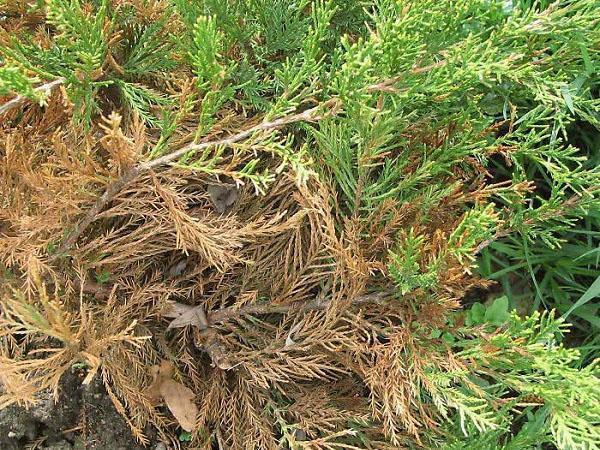Why conifers dry up - the consequence is led by gardeners
 Conifers will help to diversify the garden and make it unique. Fluffy crowns of green, yellow and blue colors fit into the original landscape design. At any time of the year, the suburban area remains colorful, but sometimes after winter the conifers dry up. Even the noblest varieties juniper may need the help of a gardener.
Conifers will help to diversify the garden and make it unique. Fluffy crowns of green, yellow and blue colors fit into the original landscape design. At any time of the year, the suburban area remains colorful, but sometimes after winter the conifers dry up. Even the noblest varieties juniper may need the help of a gardener.
Conifers dry out from burns
If the bush on the sunny side has acquired a miserable appearance, and its needles have become brown or yellow, it means that there has been a malfunction in the metabolism. Each individual part of the plant began to develop independently of each other. For example, the root system has not yet woken up, and the shoots have quickly grown.
Burns will be only on the open part of the crown, which faces the sun. Moreover, the snow cover often reflects bright rays and the juniper burns out.
This phenomenon is observed in young seedlings of coniferous crops. They become vulnerable to UV light due to dehydration. Therefore, they should be shaded in the first two years. When this happens regularly, two reasons are noted:
- the tree / bush grows in an unacceptable place for it;
- the frost resistance of the variety is not suitable for this region.
Considering the above factors, it is worth giving preference to varieties that are adapted to local climatic conditions.
"Are you cold maiden" or freezing
This is often seen in winter. With abnormal phenomena, the bush begins to freeze slightly, since the moisture supply is at its limit. Therefore, gardeners are especially attentive to:
- snowless winters;
- piercing cold winds;
- sharp changes in temperature.
The likelihood of frostbite is reduced if crops "go" for wintering with ripe shoots. Conifers should be planted in areas without drafts, then strong gusts of wind cannot harm them.
Juniper also perishes through drying up of the land. The first severe frosts begin very early, which leads to the freezing of dehydrated soil. In such conditions, the frost resistance of the variety decreases.
Expert advice
Fungal diseases progress due to the poor quality of the planting substrate. At the same time, poor maintenance makes the crop vulnerable to pathogenic microorganisms. Sadly, there is no single solution to pressing problems. An integrated approach is often required.
Since the 90s, the temperature has gradually increased. And since 2008 (the very peak of the heat) there has been a decline, which has not yet reached its climax. The imbalance is caused by changes in the atmosphere and nature of cyclones.
It is important to remember that there are areas where farming is considered risky. Therefore, experts advise to listen to your garden and find clues that nature itself whispers. It will not be superfluous to observe a few rules:
- seedlings below the snow cover shade in the first years of life;
- conifers evaporate moisture all year round, they are watered / sprayed during the growing season;
- carefully select exhibits for their region, taking into account the frost resistance of varieties;
- when landing, avoid windy places or put windscreens.
In this case, the juniper should not be overfeed. Excess is unacceptable for them nitrogen fertilizers... As a result, in the spring they take on an unsightly appearance, and the gardener has to remove all of last year's growth. It is important to understand that nitrogen-containing complexes are bought for fruit / flowering crops, but it is completely unnecessary for conifers. And here watered trees in early spring (after snow melt) and late autumn.